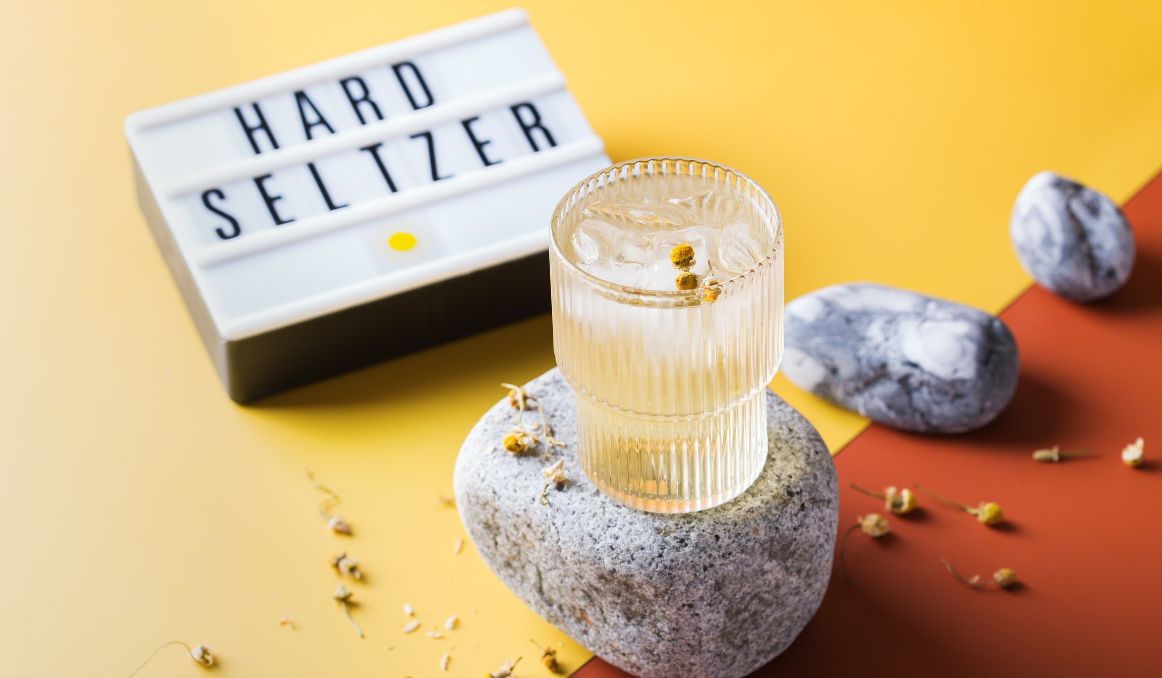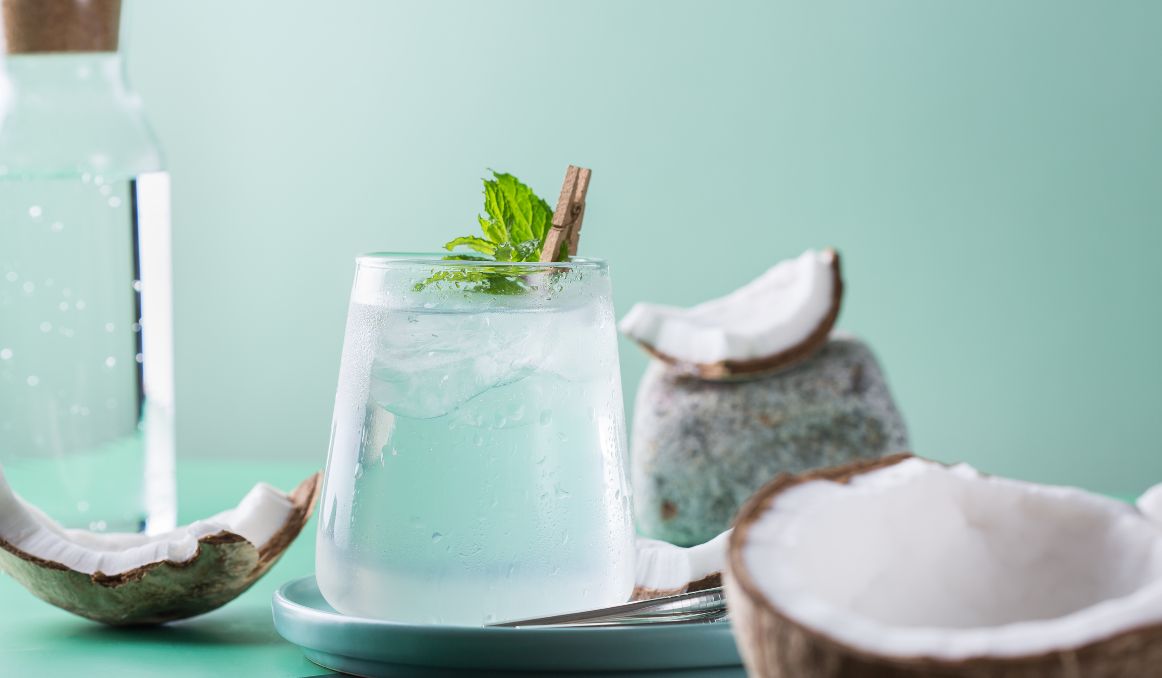What Is Hard Seltzer Made Of?
If you have not heard of hard seltzer, you must have been living under a rock or on some beautiful mountaintop for the last ten years. In that time, alcoholic seltzer in tall skinny cans took the western world by storm. White Claw may be the most famous, but Truly and Topo Chico are coming up behind it fast. Virtually every major beer and wine company now has a line catering to this bubbly buzzy beverage. But what is hard seltzer made of?
What Is Hard Seltzer?

Hard seltzer is basically fermented sugar water.
It has been compared to beer because of its lower alcohol volume, but beer is made with grain, kind of a major missing factor in hard seltzer. Furthermore, beer is naturally low in ABV precisely because grain is lower in fermentable sugars, even after the kilning process. In contrast, hard seltzer sometimes comes in as high as 10% ABV, thanks to the pure cane sugar being fermented, and the seltzer needs to be diluted, or cut, with water to bring the ABV back down.
It has also been compared to wine because of its high sugar content, allowing for a raging natural fermentation process that really does not call for much interference (unlike beer, which requires an exact science to get just right). But of course, wine is rich in body and flavor, thanks to those hearty, fruity grapes. And the ABV in wine comes in much higher than that of hard seltzer, close to 15% for many varietals.
The truth is that hard seltzer is actually much closer to rum than to any other alcoholic beverage. Rum is made from pure cane sugar fermented with water and yeast and then distilled down to liquor.
With hard seltzer, the only thing missing is the distillation process, and the only thing added is extra carbonation.
Water, sugar, and yeast are the only necessary ingredients in hard seltzer. Brewers will then add flavor and bubbles to complete the effect.
So basically, hard seltzer is a light and fizzy rum drink.
Let’s break it down.
Sugar wash
The first step in hard seltzer is the sugar wash – mixing sugar and water to create a liquid ready to ferment.
The sugar can really be anything from pure cane sugar to honey and even agave. Again, you can see here easy comparisons to rum, mead, and tequila.
The decision about sugar will have much to do with the base flavor, which should be relatively neutral.
Water is a bigger issue. Tap water and mineral water will lend themselves to flavor additions that are typically unwanted in hard seltzer, so the brewer will seek purified, filtered water as close to absolutely flavorless as possible.
The two ingredients are then combined to await the yeast.
Yeast
To the inexperienced, it might seem like yeast would be a neutral ingredient. Nothing could be further from the truth. Yeast adds a wealth of complexity in flavor and aroma, and with hundreds of strains to choose from, the onus of responsibility is upon the brewer to choose the most neutral yeast possible.
Many brewers will choose wine yeast as the alcohol tolerance is higher than an ale yeast will be, which will ensure all of the sugar gets consumed.
The danger of choosing a lower tolerant yeast for hard seltzer fermentation is that the yeast will start dying off as the alcohol levels rise, and you will be left with unfermented sugars and a sweeter beverage than you, and your consumers, want.
Once you have chosen your yeast, the fermentation process only takes a few days, sometimes up to a week.
Because you have so few nutrients and minerals to deal with, secondary fermentation to clean up off flavors is typically unnecessary.
Now, instead, you will scrub.
Scrub
Scrubbing is the filtration process for hard seltzer, as you will have slight cloudiness and maybe even a light-yellow coloring to your fermented product.
To get the liquid clean, clear, odorless, and flavorless, brewers will now “scrub” the seltzer, often using activated carbon, which cleans all unwanted substances from the brew, clarifying it along the way.
Flavor

Now that you have an odorless, flavorless, slightly fizzy beverage, you’ll want to add flavor. As one of the selling points of hard seltzer is that it is a “healthier” option for drinkers than beer or wine, fans are seeking a clean, all-natural beverage in hard seltzer.
As such, most brewers will use either real fruit flavor or an all-natural extract to add flavors.
The most popular flavors are citrusy – lime, lemon, orange, and grapefruit.
Next on the popularity list is berry and stone fruit flavor – blackberry, strawberry, and blueberry plus cherry and peach.
Those top two are followed closely by tropical flavors like mango and pineapple.
Some brewers will even add real fruit puree to the seltzer to create a thicker, creamier beverage.
Carbonation
Finally, while the fermentation process naturally creates carbon dioxide, much of the expected bubbles are lost along the way.
To provide more effervescence, brewers will force carbonate the seltzer by running it through CO2 lines immediately before canning.
Note that because the goal is a bubbly effect between beer and champagne it is rare to find seltzer in kegs as maintaining that level of carbonation on tap is difficult and indeed requires a special tap to serve it on draft.
In the end, hard seltzer is a deceptively easy beverage to brew, requiring few ingredients and steps. At the same time additional equipment is necessary, like carbon plates and CO2 lines, in order to get it just right.
As with most crafts, getting this one perfect is all about your willingness to experiment, fail, and try again.
Definitely worth the effort.
Cheers!
Whether you’re brewing seltzers, beer or wine, in order to obtain quality and product consistency you need to constantly monitor your yeast! If you’re interested in finding out how you can use our technology to control fermentation, save work hours and improve the cost-efficiency of your business, drop us a line at [email protected] or check out our product pages:
- Oculyze BB 2.0 (Better Brewing) Yeast Cell Counter App + Hardware
- Oculyze FW (Fermentation Wine) Yeast Cell Counter App + Hardware
Also, you can now get access to a fully functional demo account to test your yeast via our Web App. Completely free of charge and with no commitment to purchase.
Sources:


